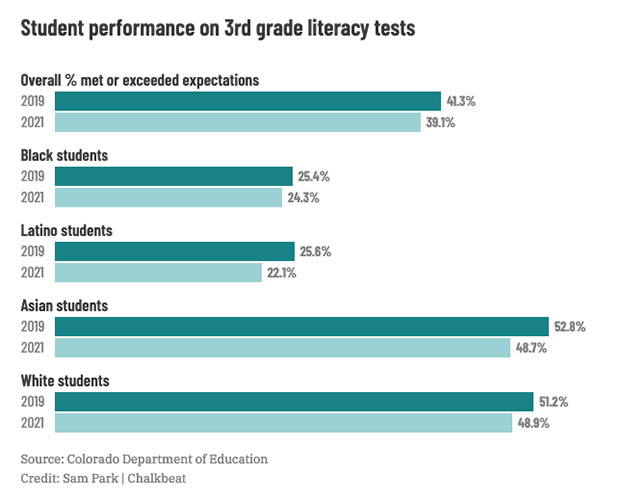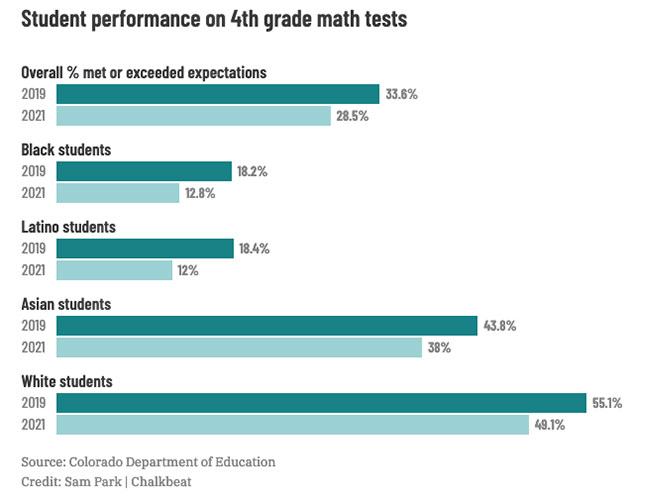This story by Erica Meltzer and Yesenia Robles appeared on Chalkbeat.org on August 12, 2021.
The Daily Post will comment on Archuleta School District CMAS scores when local data becomes available.
Data released Thursday shows that far fewer students took the CMAS (Colorado Measures of Academic Success) tests, and those who did performed at levels last seen five to six years ago. Student performance fell more in math than in literacy, a trend that matches national patterns, with the drops particularly pronounced in middle school. Students in grades three, five, and seven took the literacy test, while students in grades four, six, and eight took the math test.
“If we look at the communities that were most impacted by the virus itself, it stands to reason that those were the students who would also be impacted the most,” said Floyd Cobb, executive director of teaching and learning for the state education department. “Those are also families where parents may not have been able to work at home and where students may have had connectivity issues or not had a designated place to work.”
State education officials did an analysis that matched the demographics of 2019 and 2021 test-takers and concluded that scores would have been lower if more students took the tests, and that Colorado students have significant ground to make up.
Colorado did not track which districts spent more time in 100% remote learning, how many students opted for virtual learning in districts that offered in-person instruction, or how many days students spent in quarantines.
Amie Baca-Oehlert, president of the Colorado Education Association, the state teachers union, said she hopes the public doesn’t judge schools or educators when there was so much variation in learning, even within the same school.
“My son had three quarantines, and my daughter had one,” she said. “And that’s just one family.”
Instructional mode is just one factor that would have influenced student learning, said Marianne Perie, an independent consultant who advises states on assessments.
“What’s hard to quantify is kids who got a decent amount of instruction but they had food insecurity or a parent lost a job or a family member died of COVID,” she said. “Those things are going to affect kids because they’ll have other things on their mind besides school, even if they did get instruction.”
It’s not entirely clear why students struggled more in math, but state education officials speculated that students have more opportunities to practice reading and writing at home or in their daily lives and that doing math requires learning many new skills that don’t come up much outside the classroom.
Lacey Mueller-Taschdjian, a middle school math teacher in the Adams 14 school district, said many students were used to doing long division or drawing graphs on paper pre-pandemic, and the only device they might have used would be a calculator. She used an online platform that let students “write” with a mouse while she observed their work in real time, but students were less likely to do math outside of class or using other devices.
“Essentially when they’re texting, they are still writing. When they’re doing other stuff on their phones, they’re still engaging with reading and writing. Not math,” Mueller-Taschdjian said.
Test results for high school students taking the PSAT and SAT were more positive, though participation rates also were down. Overall, 10th and 11th grade students had higher average scores than in 2019, although 2019 scores dipped from 2018, and the gains this year did not surpass 2018 scores. In some cases, gains in reading and writing made up for dips in math.
Racial gaps persisted in this year’s results, but students in many subcategories made gains. For example, of 11th grade students who took the SAT, Black students had an average combined score of 916, up from 899 in 2019, the largest increase. Hispanic students had a combined average score of 910, up from 904; and white students had an average combined score of 1066, up from 1060.
Students who were ninth graders in the 2020-21 school year struggled more than ninth graders in previous years. The combined average score from their PSAT this spring was 903, down from 906 in 2019.
Based on score thresholds created by Colorado, 60% of 11th graders who took the test met or exceeded state expectations in reading and writing, up from 58.6% in 2019.
Colorado school districts, school boards, and teachers unions called for the tests to be canceled altogether, while education advocacy groups and Gov. Jared Polis said tests would provide valuable information. While groups on all sides came together to support the reduced-testing compromise, the debate over the meaning of the tests is not over.
“You never give a test and make all your decisions based on one data point, but it is part of the bigger picture of where kids fell behind and where we owe kids the biggest investment,” said Tyler Sandberg, vice president of the conservative education advocacy group Ready Colorado. “Quantifying that is really important. And I think it will light a fire for innovation.”
Bret Miles, head of the Colorado Association of School Executives, said school districts already know which students struggled more and have used federal money to offer summer school and hire interventionists.
“That’s the thing about CMAS,” Miles said. “It’s such an autopsy instead of a checkup. School districts already have a good plan. They were not waiting around for this data to come out.”
Christine Pitts, a resident policy fellow at the Center on Reinventing Public Education, said district leaders have been “flying blind” for much of the pandemic. While state assessments have limitations, the data should prompt important conversations between school leaders and community members about what students need.
“If I were a superintendent, I would definitely use the state data to provide context for my local assessment data,” Pitts said. “I would not ignore it.”
Researchers likely will spend the next decade trying to unravel the effects of the pandemic, but Perie said one thing is clear: “We owe the students more learning,” she said.


